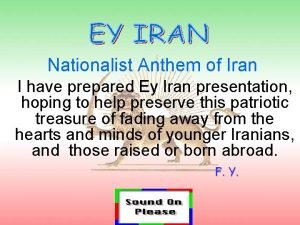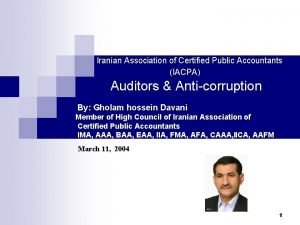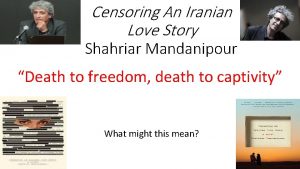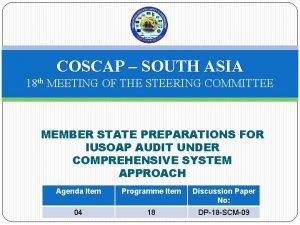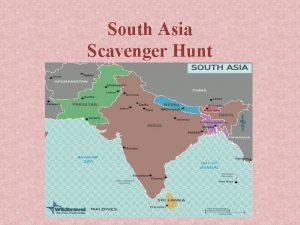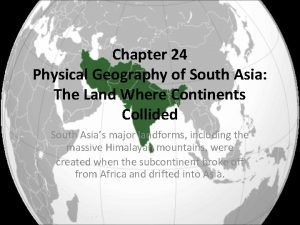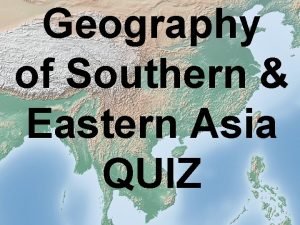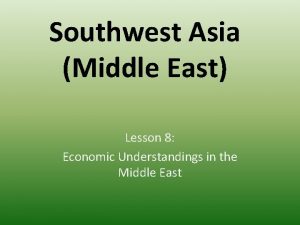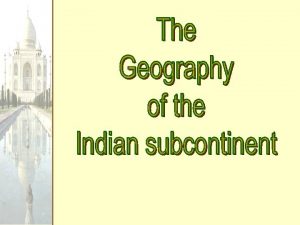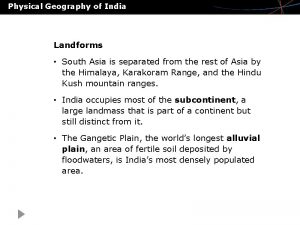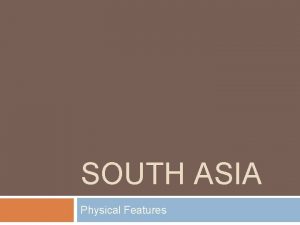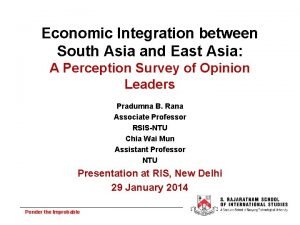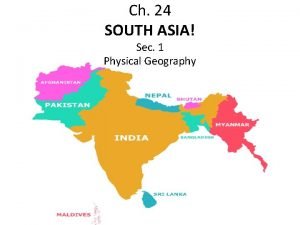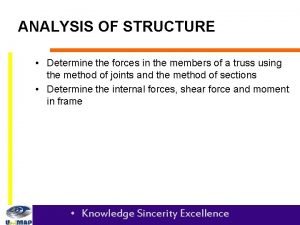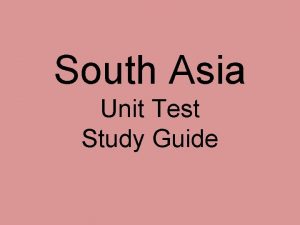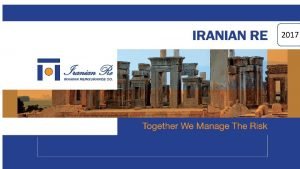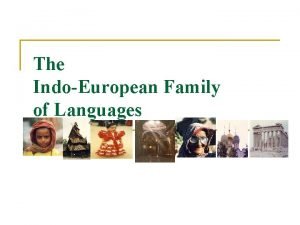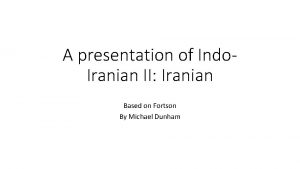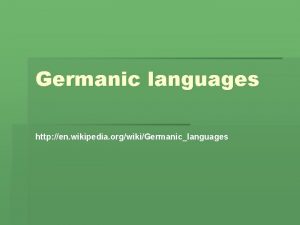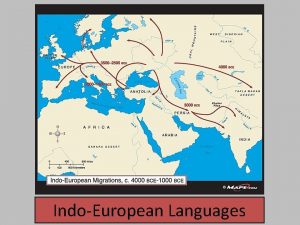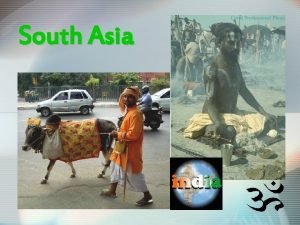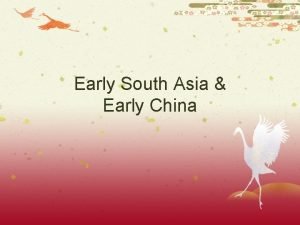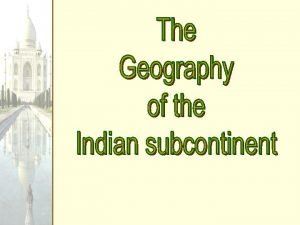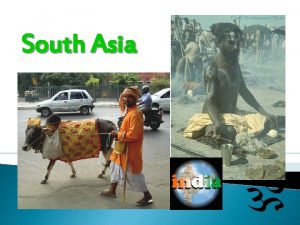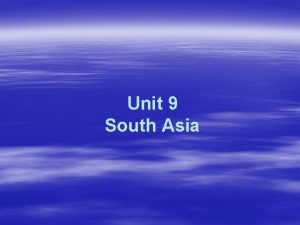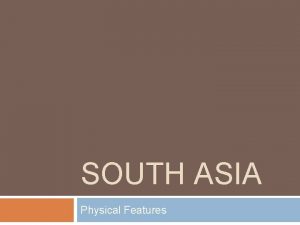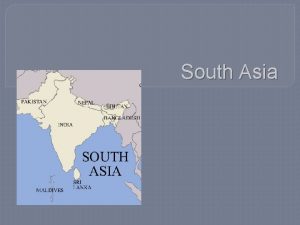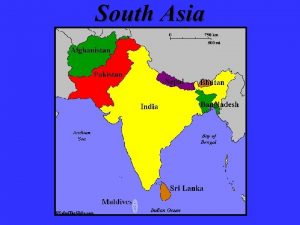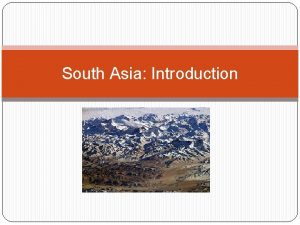Iranian languages South Asia IndoEuropean languages of the

























- Slides: 25

Iranian languages; South Asia

Indo-European languages of the area Aryan Nuristani Kati Indo-Iranian Dardic Kashmiri… Iranian Persian (Farsi, Dari, Tajiki), Kurdish languages, Balochi, Pashto… Indo-Aryan

Iranian languages

Iranian languages Wikipedia. org

South Asia Карта: Matthew Dryer

South Asia as a linguistic area Dravidian Indo-European Indo-Aryan Iranian (areal periphery) Dardic Nuristani Sino-Tibetan (areal periphery) Austroasiatic (areal periphery): Munda Burushaski

Languages of India 1991 Census of India: 114 languages < 1, 576 mother tongues (with more than 10, 000 speakers) + 1, 796 “unclassified” mother tongues The largest languages: Hindustani: Hindi (> 260 mln), Urdu (> 63 mln. ) Bangla (> 193 mln. ), Gujarati (> 46 mln. ), Dravidian: Telugu (> 74 mln. ), Tamil (> 68 mln. ) , Kannada(> 37 mln. ), Malayalam (> 33 mln. )

South Asia as a linguistic area Colin Masica: Retroflex consonants Postpositions, OV, Adj N Ideophones, echo-reduplication “Dative subjects” Hindi (Bhatt 2003) Quotatives: specific complementizers introducing direct speech (< forms of the verb ‘say’)

History: Iranian languages Old Iranian Avestan beginning of the 1 millenium BCE Old Persian 6 -4 c BCE … Middle Iranian 4 c BC – 1 millenium AD Middle Persian (Pahlavi), Sogdian, Parthian, … New Iranian

History: Indo-Aryan languages Old Indo-Aryan Vedic Sanskrit mid 2 nd millennium – 3 -2 c BCE Classical Sanskrit mid 1 st millennium BCE, Panini Indian epic poetry 3 -2 c BCE: Ramayana, Mahabharata Middle Indo-Aryan Prakrits, Pali, Apabhraṃśa (mainly the 1 st millennium AD) New Indo-Aryan

sanskritweb. net

General tendencies From synthetic languages to analytic languages (postpositions, etc) From fusion to agglutination From VO to OV From accusative alignment to split accusative/ergative alignment Originally dependent marking, later pronominal clitics akin to head marking

General tendencies These tendencies are not found everywhere, though. Dravidian lgs are more or less synthetic In India more analytic languages are located in the eastern part Kashmiri: the usual order is SVO

Complex predicates / compound verbs Predicates normally consist of two (or more parts). Persian (Karimi 2008) Persian only has about 130 simplex verbs. (Cf. the same picture in East Caucasian. ) Urdu (Butt 2005)

Complex predicates “Lexical verb” + Light verb (which contains the grammatical information). Monoclausality: Complex predicates do not constitute several clauses. Probably “complex predicates” is an umbrella term for a number of more or less different phenomena.

Case systems In many modern Indo-Iranian languages, case systems are considerably reduced (up to 2 -3 cases). The borderline between cases and postpositions is not always obvious. Hindi: Basic cases Nom & Obl vs “Secondary” cases/postpositions (Erg, Gen, Dat/Acc, Abl/Instr etc. ) Dravidian languages: Many markers treated as locative cases in some descriptions are thought to be postpositions in other descriptions.

Partial ergativity In many Iranian, Indo-Aryan and Dardic languages, one observes ergative alignment in past tense (or in (some) past tenses). (Haig 2008: 12)


Partial ergativity In fact, in Hindi in past tense (de Hoop & Narasumhan 2008)… ergative marker is found on the most volitional agents ergative clitic marks volitionality even with some intransitive verbs:

… on a par with DOM In many Indo-Aryan and Iranian languages the specific/referential patient takes peculiar marking. Hindi (de Hoop & Narasumhan 2008) NB: =ko is the dative postposition

Iranian languages: word order Don Stilo: Many Iranian languages violate statistical universals related to word order and differ between each other For example, basically OV but

Iranian languages: word order Possible explanation: Iranian languages as a “buffer zone” between left-branching languages (e. g. , Turkic) and right-branching languages (e. g. , Arabic). Possible remarkable consequence: circumpositions (fit into any branching tendencies). Kurdish (Mc. Carus 2009):

Iranian languages: ezafe Primarily in Western Iranian, there is a specific marker which links the head and the attribute (adjective, possessor, sometimes relative clause) Persian (Kahnemuyipour 2006) mard-e châq ‘fat man' man-Ez fat Head marking? Or not? (Ezafe occurs immediately before the attribute, not necessarily on the head). Cp. Zaza Kurdish [láz- mь n]-o pil ‘my elder son’ son-EZF. POS. M 1 SG: OBL-EZF. ATR. M elder (Smirnova, Ejubi 1998: 35)

South Asia: causatives Some languages distinguish between direct and indirect causatives. Hindi (Bhatt 2003): Direct (contact) causative: Indirect (distant) causative:

South Asia: ideophones Dravidian languages: Malayalam, Kannada, Telugu
 Indo iranian languages
Indo iranian languages Apush eisenhower
Apush eisenhower Iranian revolution timeline
Iranian revolution timeline Ey iran national anthem
Ey iran national anthem Iacpa
Iacpa Censoring an iranian love story
Censoring an iranian love story Coscap south asia
Coscap south asia Asia africa song
Asia africa song Asia scavenger hunt
Asia scavenger hunt South asia physical geography
South asia physical geography Southern and eastern asia physical features answer key
Southern and eastern asia physical features answer key Lesson 8 middle east and south asia
Lesson 8 middle east and south asia Geography of sw asia color by number
Geography of sw asia color by number South asia satellite
South asia satellite Pearson education south asia pte ltd
Pearson education south asia pte ltd Reteaching activity 24 cultural geography of south asia
Reteaching activity 24 cultural geography of south asia Political map of north africa and southwest asia
Political map of north africa and southwest asia Chapter 25 human geography of south asia
Chapter 25 human geography of south asia Landforms in south asia
Landforms in south asia Physical features map of south asia
Physical features map of south asia South asia
South asia South asia map physical features
South asia map physical features South asia map ganges delta
South asia map ganges delta Identify zero force members in the truss
Identify zero force members in the truss South asia unit test
South asia unit test Arya south asia 46m 14msinghtechcrunch
Arya south asia 46m 14msinghtechcrunch



